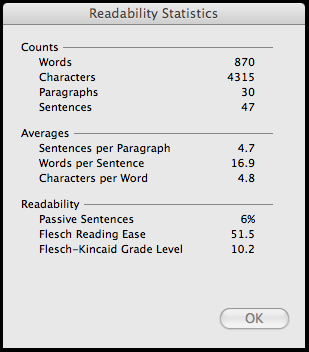A recent study by researchers at Loyola University found that as many as 63% of prostate cancer websites cannot be read or understood by someone who hasn’t completed high school education. Why is this important? Well, one of the study’s references suggests that as many as 90 million adult Americans have literacy skills that test below high school reading levels. This is despite the fact that 87.58% of US adults over 25 years old have a high school education (US Census Data). Also, people with lower socioeconomic backgrounds may have even lower reading levels (as much as 7th-8th grade, on average). In fact, The National Institute of Health (NIH) recommends that providers prepare patient education material suited to fit 4th through 6th grade reading level.
I personally think that the target set by the NIH is unrealistic for complex medical topics. However, when medical information is presented in a way that is more understandable, the better it is for people that suffer from a serious medical condition, such as cancer, or those that care for them.
The Flesch-Kincaid Grade Level
What was most fascinating for me, though, was learning of the Flesch-Kincaid grade level evaluation. This is a tool that automatically assesses the readability of a written text. In order to assess the readability of a given text, one does not need to actually study a diverse group of people reading a text. The Flesch-Kincaid grade level provides a good enough approximation of what the grade level readability of a given text is.
The Flesch-Kincaid grade level is a function of the average number of syllables per word and the average number of words per sentence. It’s formula is quite simple:

It turns out that Microsoft Word has a tool that can assess the Flesh-Kincaid grade level of text in a Word document. Microsoft introduced this feature back in Office 2003, and it exists in all versions since. This feature needs to be turned on, as it is off by default, but once activated, anyone can easily assess the readability of a given text (see how to activate it here). If you prefer, you can use this free online tool. Google Docs had these features and curiously removed them 2 years ago.
The Flesch-Kincaid evaluation method isn’t new. Nor is it the only method. There are many more methods (and here), though it is probably the most popular. Also, readability depends on many other factors besides those mentioned in Flesch-Kincaid. Visual layout and content, of course, are also significant. These readability evaluation methods have been used to evaluate anything from presidential rhetoric to credit card contracts.
Assessing Readability of my Blog
I wanted to see whether complex material could be presented in a readable manner. This brought me to think about testing my blog. I wanted to see how understandable my blog was; at what grade level could you comfortably read and understand my blog? In order to test this, I took the last 6 blog posts and ran the test on them. Here’s what I came up with:
|
Blog Post |
Flesch-Kincaid Grade Level |
| The Illusion of Privacy |
9.1 |
| My 2012 Predictions |
9.3 |
| My iPhone 5 Predictions |
9.4 |
| Did competition kill flip or Cisco fumbled |
10.8 |
| Pricing of inflight entertainment |
9.7 |
| Communication Chaos |
8.5 |
I was pleased to learn that anybody with 10th grade English reading level could read my blog.
Relevance to Medivizor
So, at Medivizor, which I introduced to you last week, among the many things we are trying to do, we aim to make complex medical and scientific material more accessible to people to whom it matters. We decided to test how readable the material we intend for users is. At first, test results showed that our readability levels were suited to grade 15-16. That meant that our users would have to possess a reading level common to people with 4 years of university or college education.
We felt that this wasn’t good enough. If 10th graders could understand my blog, we should be able to make the medical information more understandable. So, using the Flesch-Kincaid scoring level we set ourselves a target to present our valuable summaries of medical material at the readability level of 10th-12th grade. Most general / basic material will be presented even below 10th grade readability levels. For instance, for more introductory material we have achieved 7th grade level of understandability.
How to Make Material More Readable / Understandable?
According to the Flesch-Kincaid formula, it’s VERY simple: Just reduce the number of syllables in words and the number of words in sentences. Use shorter words and shorter sentences. Indeed, our anecdotal tests show that material with lower Flesch-Kincaid grade levels is easier to read and understand than those with higher grade levels.
Conclusions
Medical information can be complex. That said, it is possible to make this information simpler, better understandable, and therefore more accessible. At Medivizor, we chose to use Flesch-Kincaid grade level as a method to set our target and standardize our written matter. We believe this makes information clearer, more consistent, understandable, and usable for our users. This is something you can do too!
As always, I would love to hear your thoughts, comments, and suggestions!







Tal,
There’s also a WordPress plugin with the same Flesch-Kinkaid as well as other readability scores – it shows that information when you edit the post in realtime.
You can find it here: http://wordpress.org/extend/plugins/word-statistics-plugin/
Thanks for the tip! I didn’t realize that Word had this, and will definitely be turning it on. When drafting consent templates for a clinical study, this will be very handy.
Very interesting subtle topic. A next level of readability is the flow of information, the old story board.
I wondering if you can get 6th grade level for complicated topics by using basic multimedia, rather than plain text. For example, the cartooning video scribe, quickdraw or whatever that’s being called.
My favorites are from The Story Of Stuff Project; like the story of bottled water http://bit.ly/sqfA7O. The same site has a section with the scripts of the stories. For the he one mentioned above, I checked the grade level in MS Word, and scored 7.3.
This post by itself is 7.6 so I hope everyone can read it! 🙂
This is very informative indeed. I was also unaware of these MS-Word and WordPress features.
However, I just send my recent blood test results through a Flesch Kinkaid test – the results are surprisingly 1.30, and I am rather certain that my 7 year old can understand pretty much nothing of it.
Thinking of my doctor’s summary, it is also a very short text sequence, usually abbreviated (and in awful handwriting).
I can’t wait to read about what qualitative measures you are planning to include in your service!
Great post. Brevity and conciseness are key to understanding complicated texts. Sometimes you need to dummify a text as if you’re explaining it to a 5 year old, and all of the sudden it becomes so clear:
http://vimeo.com/27060669
Good luck with your venture.
Thanks to all!
Great comments.
Tsahi, I didn’t know about that plugin. Not useful for me, as I usually prepare my posts and then just upload to wordpress. Still, many bloggers do blog directly in the platform.
Eduardo, loved the “story of stuff” – am using the water bottle examples regularly now!
Meredith, health information is probably the most in demand of this – but there are more. Glad you can find it useful.
Ilan, a lot of things can confuse the automatic systems – you need to cut arbitrarily short sentences such as just labels for fields and such – they lower the score but are not necessarily contributing to actual readability.
Gur, great video! The Office has some good stuff 🙂
One more thing – I just saw a Gizmodo article about the readability of Wikipedia, which turns out to be much worse than some expect. Check it out here (headline) an full article.
Thanks!
Tal
One more ingredient to the soup.
I just read about ventilated prose which was discovered in the 1930 by B. Fuller (http://webhome.cs.uvic.ca/~vanemden/zzVentProse.html) – Friend Google has more to say on the subject
It may be an option on framing the information to improve yet more readability